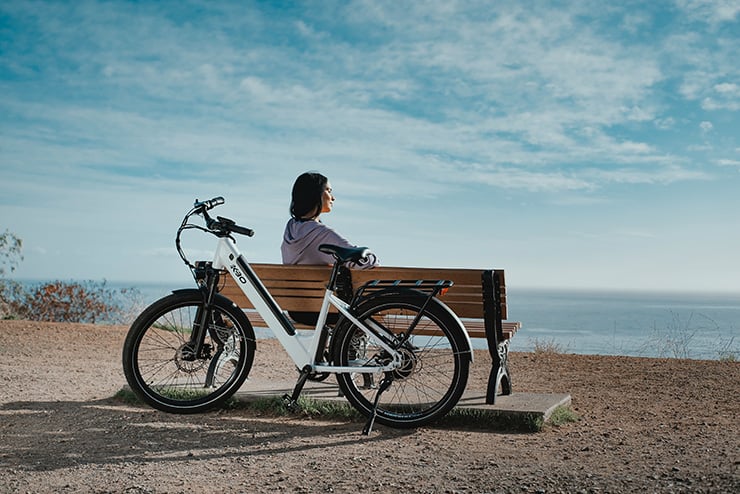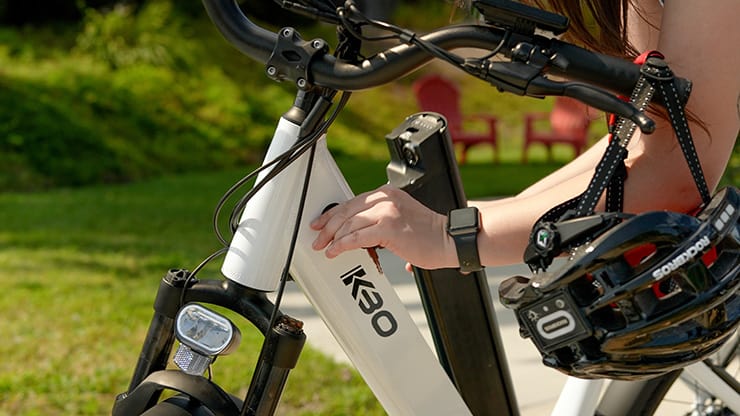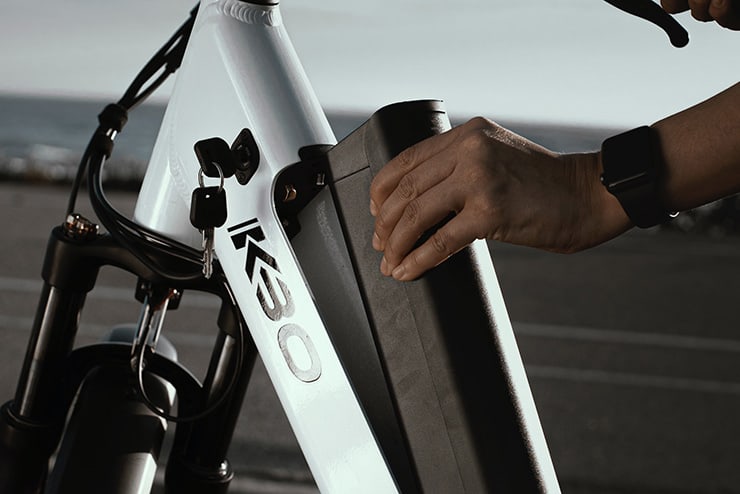Electric bikes are awesome, and it’s no surprise they’re becoming increasingly popular. It’s fun, and you can pedal fast and far, regardless of your fitness level. Besides, you’ll get a good workout. What’s not to love?
But seeing as these e-bikes use batteries, it’s normal to wonder how far you can ride before it runs out of charge. How long do electric bike batteries last? After how many years will you need to replace the battery?
The type of battery, its capacity, and your cycling lifestyle are all some of the factors that determine how long it will last. There’s no simple answer. But I will discuss everything you need to know about the battery life of an e-bike battery so you know what to expect.
I’ll also be answering the most frequently asked questions.
Key Takeaways
- Electric bike batteries are mostly lithium-based and can last about five years or 500 charge cycles before their efficiency declines.
- A single charge can go for 20 to 70 miles. It depends on many factors, such as battery capacity, terrain, rider weight, pedal assist level, speed, tire pressure, etc.
- E-bikes are water-resistant but not waterproof. They should be stored in a cool and dry place. Extreme heat or cold can damage the battery and reduce its performance.
- Always recharge the battery when it has 30% to 60% left. Shorter recharging cycles are good for the battery. Every 30 cycles, let the battery discharge completely and recharge fully.
- E-bike batteries can be repaired by qualified professionals. Replacement batteries can cost from $400 to $1000 depending on the brand and quality.
The Lifespan of Electric Bike Batteries
A good quality electric bike battery can last about five years. However, it’s less about the years and more about charge cycles.
The lifespan of a battery is rated in cycles (e.g. 500 charge cycles, 1000 charge cycles, etc.) When the battery discharges completely, and you recharge it back to full capacity, that’s one cycle. If it only discharges to 50% and you recharge it, that counts as half a cycle.
Ebike batteries, like pretty much everything else, degrade over time. This means that over the years, its capacity will reduce. In this case, once a battery has been through a certain number of charge cycles, performance will be reduced. I’ll talk more about charge cycles further below.
Most electric bikes run on lithium batteries. They are more reliable and efficient compared to nickel and lead batteries as they can withstand a higher number of charge cycles. Lead batteries have the lowest charge cycle rating, followed by nickel batteries.
That said, there are other factors that affect a battery’s life. This includes how much you use your e-bike, storage, and general maintenance. With good care, your ebike’s battery can serve you for a long time before you’ll have to replace it.
So let’s talk about how you can make your electric bike battery last longer.
How Long Do E-Bike Batteries Last on a Single Charge?
On average, you can expect to travel between 20 to 70 miles on a single charge. However, this can vary significantly, and figures online are all over the place. We will help you make some sense of this.
Riding on hilly terrain will consume more battery power compared to flat terrain. The amount of pedal assistance you’re using to get up those hills also significantly affects your range. It also stands to reason that the rider’s weight is also a factor, as your bike’s motor is working harder to push more weight along. These three make up the most significant drains on your e-bike battery.
Additionally, there are a few other things to consider, such as how aggressively you ride. Faster acceleration and higher riding speeds will drain your battery faster.
Low tire pressure will create more drag, and headwind resistance will mean working your motor harder.
In actual fact, the range of an electric bike on a single charge depends on many of the same factors that apply to your old analog bike, except instead of your body being tired, your battery drains.

How to Determine an eBike’s Range
OK, here’s the technical bit.
To determine an e-bike’s range, start with the battery capacity measured in Watt hours (Wh). Convert volts and amp hours to Wh by multiplying them. For example, a 48V 10Ah battery is a 480Wh battery.
Calculate the effective range by dividing the battery’s watt hour capacity by the average efficiency in Wh/mi (or Wh/km). Efficiency may vary based on factors mentioned earlier. Generally, most throttle e-bikes of 500-750W at an average speed of 20 mph (32 km/h) on slightly hilly terrain have an efficiency of around 25 Wh/mi (15.6 Wh/km).
A 480Wh battery would provide approximately 19 miles of range (480 Wh ÷ 25 Wh/mi = 19.2 miles).
Pedal assist e-bikes are more efficient. At speeds of 15 to 18 mph with medium pedal assist, the efficiency is around 15 Wh/mi (9.4 Wh/km). Using the same 480Wh battery, a pedal assist e-bike would offer around 32 miles of range (480 Wh ÷ 15 Wh/mi = 32 miles).
We advise getting a bike with a stated range that exceeds your average ride distance by around ⅓. This will give you a nice reserve to deal with most issues, such as terrain, while not moving a bike around with a huge heavy battery you don’t need or use.
It’s also good practice not to fully discharge your battery as this can affect its lifespan.
Heavy batteries can affect how your bike feels to ride and are more expensive, so find your sweet spot.
How Do You Extend the Life of Your E-Bike Battery
Be Careful With Water
Electronics and water are not good friends, and your electric bike battery is no different. So it goes without saying that you should never submerge your bike’s battery.
Proper care and maintenance are The keys to keeping your e-bike battery last for an extended period.
But how about splashes and rain? Sometimes you can’t avoid cycling in the rain or getting water splashed on your bike.
Fortunately, most e-bikes are water-resistant, and you can ride or park them in the rain. Usually, manufacturers will advise on whether an electric bike can get wet or whether you should completely avoid wet conditions. So check your owner’s manual.
Good Storage Is Key
E-bikes are designed for outdoor use, so they can handle being out in extreme conditions. But when it comes to storage, you must be careful if you want your ebike battery to last. Store it in a cool and dry place.
Heat is bad for your electric bike’s battery. High temperatures will quickly lower your battery’s capacity and performance. Avoid leaving your bike out in the heat under direct sunlight for a long time.
Extremely cold temperatures aren’t any better either, as the battery’s capacity will be affected too.

Charge the Battery Properly
Most people don’t really consider how they charge their ebike batteries. Charging an electrical device properly can prolong its battery’s lifespan.
First, it is not advisable to let lithium-ion batteries regularly discharge entirely. It is better to let the battery discharge partially and have shorter recharging cycles. After about 30 charge cycles, you can allow a complete discharge and then charge it fully for it to recalibrate itself.
Most electric bike manufacturers say that regular use and, consequently, regular charging could prolong your battery life. For this reason, they recommend charging your battery when it has about 30% to 60% charge remaining.
How Often Should You Charge Your Electric Bike Battery?
I have discussed the proper charging of an ebike battery above. Going by the recommended guidelines, how often you charge your lithium battery will depend on your cycling lifestyle.
If you use your electric bike regularly, you will need to charge it more often because it will discharge faster. You don’t need to charge your bike battery after every ride, only when it falls to the range we’ve discussed, at least 30%.
However, if your next ride will be a long one, you can top it up to 100%. You don’t want the battery to run out of juice while you’re out cycling.
Good high-capacity batteries can hold power for long periods. So it will take some time for them to get down to 30%.
E-Bike Battery Charge Cycles and Why They’re Important
As mentioned, manufacturers measure battery life in charge cycles. If it is given as 500 charge cycles, that’s the number of full cycles that it can withstand before its efficiency starts declining.
After that, you may notice that the power capacity is lower, and the battery discharges quicker. You will be charging it more frequently.
This isn’t to say that it will be pretty much unusable as soon as the battery hits 500 charge cycles. The decline isn’t that drastic, so it doesn’t mean that after 500 cycles you’ll need a replacement battery.
It will still be usable but with a lower capacity, usually around 60 to 80%. This charge cycle rating gives you an idea of how your e-bike’s battery will age. If the battery still serves you well, you can continue using it.
Can You Repair an Electric Bike Battery?
Unfortunately, your electric bike battery will wear over time, regardless of how well you take care of it.
But the good news is that you can repair an ebike battery. It’s much cheaper than buying a new one–good ebike batteries don’t come cheap. Battery cells, wiring, casing, and other parts can be repaired or even replaced.
However, this is not something you should try on your own. You may end up causing further damage. It is best to let a qualified person do it. They will also let you know whether the battery can actually be repaired or if it’s time to replace it.
The Cost of Replacing an E-Bike Battery
A typical electric bike battery will cost anywhere from $400 to about $1000. It depends on the brand, capacity, and, of course, quality.
Big brands, like Shimano, will cost more, and it’s not surprising to find some going for more than $1000. There are also many cheap brands, and you don’t have to look hard to find electric bike batteries for less than $400.
Just know that cheap is expensive, and more often than not, you get what you pay for. You don’t have to buy a $1300 ebike battery, but that doesn’t mean you should go for a cheap, questionable brand. You can find some good ones that range somewhere in the middle.

Signs That It’s Time to Replace Your Electric Bike Battery
There are a few ways to tell whether it’s time to get a new battery for your electric bike. The most obvious one is that you have to charge it more frequently. If you could cycle about 40 miles, but now you can’t go 10 miles without recharging, it could be time.
Another sign is reduced performance. You may notice that your bike is much slower, and navigating hilly terrain is getting more difficult.
Lithium batteries can swell, which is a clear indicator that your battery is bad and you need another one.
Frequently Asked Questions About Electric Bike Batteries
How Far Can an Electric Bike Go on One Charge?
There’s no straightforward answer because it depends on your battery’s capacity and how you ride. But generally, you can cycle 20 to 70 miles on a single charge.
Should I Charge My E-Bike After Every Ride?
No, you don’t have to charge your ebike after every ride. Manufacturers advise charging your ebike battery with 30% to 60% of charge left. So if you have more than that after your ride, there’s no need to recharge.
Is It OK to Leave My E-Bike Charging Overnight?
Some experts say it’s okay to leave your ebike charging overnight. Popular ebike battery brands are designed to stop charging automatically when the battery reaches 100%. Just make sure you use the correct charger. Others say it may damage the battery and cause other problems, like fires.
Read the owner’s manual and follow the recommended procedure to avoid issues. If you’re in doubt, don’t do it.
Bottom Line
So, how long do electric bike batteries last? Ebike batteries can last about 5 years, depending on a specific battery.
The lifespan of an ebike battery is given in charge cycles. So if it’s 500, that’s the number of charge cycles it can take before its efficiency declines. After 500 charge cycles, you may notice that the capacity is lower and doesn’t last as long as it used to.
You can adopt a few practices to make your electric bike battery last longer. First, charge it properly. Don’t let the charge drop below 30%. Shorter recharging cycles are better for your battery. However, every once in a while, let it discharge completely so it can recalibrate itself.
Don’t store your ebike in extreme temperatures–hot or cold. While most batteries can handle getting rained on or water splashes, never submerge it in water.

